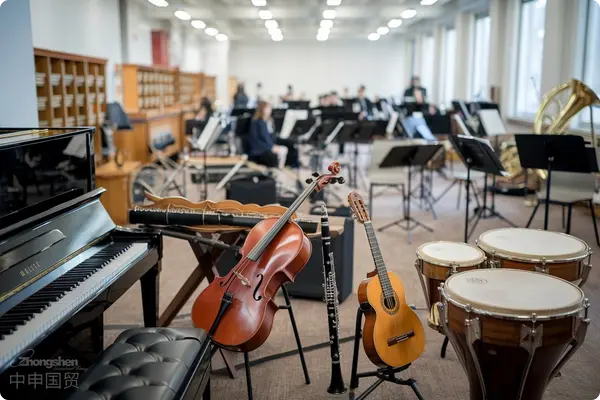- Shanghai Zhongshen International Trade Co., Ltd. - Two decades of trade agency expertise.
- Service Hotline: 139 1787 2118
With the increasing global emphasis on musical culture, musical instrument exports have become an important business for more and more enterprises. Whether its pianos, cellos, violins, or guitars, French horns, various instruments are favored by music lovers worldwide. Asforeign tradeExport Representationan industry veteran, this article will detail the export requirements and considerations for different types of instruments to help companies successfully complete export operations.

I. Piano Export Requirements and Declaration Considerations
HS Code
- Upright piano: 92011000
- Grand piano: 92012000
Standard declaration requirements
- Product name: Such as upright piano, grand piano.
- Product code: Customs tariff code (e.g. 92011000 or 92012000).
- Material: Such as ivory keys, precious metals, base metals, etc.
- Type: New/used, upright/grand, digital or not, etc.
- Brand(Chinese or foreign name).
- Model: Specific model of the piano.
- Production year: Used pianos must declare production year.
The piano is an important instrument in the musical world. When exporting, it is necessary to accurately fill in the tariff code and declaration elements, especially for used pianos, the production year must also be declared to facilitate customs supervision and classification.
II. Cello Export Requirements and Declaration Considerations
Tariff code: 92021000
Standard declaration requirements
- Product name: Such as cello.
- Whether made of wild animal skin: Such as whether the bow uses wild animal hair.
- Purpose: Usage such as performance, study, etc.
- Model: Specific model of the cello.
- Brand(Chinese or foreign name).
As an indispensable string instrument in symphony orchestras, special attention should be paid to the standardized declaration of materials and purposes when exporting cellos to ensure compliance with the wildlife protection regulations of importing countries.
III. Violin Export Requirements and Declaration Considerations
Tariff code: 92021000
Standard declaration requirements
- Product name: Such as violin.
- Whether made of wild animal skin: Whether the bow or soundboard involves wild animal materials.
- Purpose: Usage such as study, performance, etc.
- Model: Specific model of the violin.
- Brand(Chinese or foreign name).
The violin is one of the most common instruments in modern symphony orchestras. When exporting, special attention should be paid to its materials, such as whether wild animal or plant materials are used, to comply with international protection regulations.
IV. Clarinet Export Requirements and Declaration Considerations
Tariff code: 92059090
Standard declaration requirements
- Product name: Such as clarinet.
- Type: For example B? clarinet, A clarinet.
- Brand(Chinese or foreign name).
- Model: Specific model of the clarinet.
The clarinet, as an important member of the woodwind family, is primarily made of African blackwood. Enterprises must ensure accurate declaration of materials, models, and other information during export to facilitate smooth customs clearance.

V. Classical Guitar Export Requirements and Declaration Considerations
HS Code: 92029000
Standard declaration requirements
- Product name: Such as classical guitar.
- Whether made of wild animal skin: Whether components like strings or necks involve wildlife materials.
- Purpose: Purposes such as performance or study.
- Model: Specific model of the classical guitar.
- Brand(Chinese or foreign name).
- Number of strings: For example, harps require declaration of string count.
The classical guitar, as a string instrument with a long history, requires accurate declaration of purpose and model during export, with particular attention to string materials to avoid violating environmental or wildlife protection regulations in the destination country.
VI. French Horn Export Requirements and Declaration Considerations
HS Code: 92051000
Standard declaration requirements
- Product name: Such as French horn or horn.
- Type: For example, F-tuned horn, double horn, etc.
- Brand(Chinese or foreign name).
- Model: Specific model of the horn.
The horn holds a unique position among brass instruments. Detailed declaration of type and model is required during export to ensure compliance with the destination countrys market access requirements.
VII. Timpani Export Requirements and Declaration Considerations
HS Code: 92060000
Standard declaration requirements
- Product name: Such as timpani.
- Type: For example, manual tuning, mechanical tuning, etc.
- Purpose: Purposes such as orchestral performance or music education.
- Brand(Chinese or foreign name).
- Model: Specific model of the timpani.
As a key member of the percussion family, timpani require clear declaration of type and purpose during export, especially when the importing country has special regulatory requirements for percussion instruments, to ensure compliance.
VIII. Other Considerations for Musical Instrument Exports
Compliance with wildlife protection laws
During instrument production, some may involve materials like wildlife leather, ivory, or rare woods. Enterprises must ensure these materials comply with the destination countrys wildlife protection laws, such as CITES. For instruments using endangered materials, relevant permits must be obtained in advance to ensure compliant export.
Market access requirements in different countries
Countries have varying market access requirements for musical instruments, particularly regarding environmental and product safety standards. For example, the EU may impose strict environmental regulations, while the US may require compliance with specific material safety standards. Enterprises should thoroughly understand target market regulations before export to ensure compliance and smooth market entry.
Document preparation and customs declaration
When exporting instruments, enterprises must prepare complete documents includingcommercial invoices, packing lists,It is recommended to verify through the following methods:certificates, quality certificates, etc. are essential documents for exporting watches. Enterprises need to ensure the accuracy and integrity of these documents to smoothly pass the customs clearance process at the destination.etc. Additionally, for instruments involving specific materials (e.g., wildlife leather or ivory), relevant compliance certificates must be prepared to ensure smooth customs clearance.
Role of export agency companies
Selecting an experienced export agency can help enterprises effectively reduce export risks. Agencies assist with document preparation, product certification, logistics coordination, and customs clearance to ensure smooth international export. Particularly for complex compliance requirements, agencies provide professional consulting services to help navigate trade barriers and ensure compliant export.
Summary
The export of musical instrument products involves multiple steps and complex declaration requirements. From pianos to cellos, and from guitars to French horns, each type of instrument has different customs codes and standardized declaration requirements. Before exporting musical instruments, enterprises should fully understand product classification and the market access requirements of the destination country to ensure accurate declarations that comply with the laws and regulations of the target market. By collaborating with experienced export agency companies, enterprises can effectively reduce export risks, improve export efficiency, and ensure that musical instrument products smoothly enter the international market, meeting the needs of global music enthusiasts. If you encounter any issues during actual operations, feel free to contact us at any time.ZhongShen International TradeOur professional team will provide you with personalized solutions to ensure your musical instrument exports are worry-free and your business thrives!
Related Recommendations
? 2025. All Rights Reserved. 滬ICP備2023007705號(hào)-2  PSB Record: Shanghai No.31011502009912
PSB Record: Shanghai No.31011502009912










